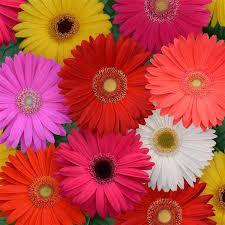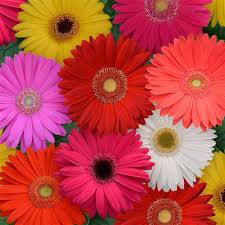Gerbera Daisy Mega Revolution Mix
Gerbera Daisy Mega Revolution Mix
Daisy Mega Revolution is a striking variety of Shasta daisy (Leucanthemum x superbum) known for its large, bold flowers with crisp white petals and a vibrant yellow center. The Mega Revolution series is known for producing larger-than-usual blooms compared to typical daisies, making them stand out in any garden or landscape. These daisies are perfect for gardeners looking to add a dramatic, yet classic, touch of color to their flower beds or borders.
The plant has a strong, upright growth habit and features dark green, lance-shaped leaves that provide a lush backdrop for the large daisy blooms. The flowers are excellent for both ornamental purposes and cut flower arrangements, offering a long blooming period during the summer months.
Plant Characteristics:
- Height: Typically grows to a height of 24-36 inches (60-90 cm), although it may reach up to 40 inches (1 meter) in ideal conditions.
- Width: Mega Revolution daisy plants have a spread of about 18-24 inches (45-60 cm), giving them a moderately bushy appearance.
- Flowers: The large, daisy-like flowers are 3-4 inches (7-10 cm) across, with white petals and a prominent yellow center. These flowers are typically produced in abundance throughout the blooming season.
- Foliage: The plant has dark green, lance-shaped leaves that are healthy-looking and provide good contrast against the white and yellow blooms.
Growing Zones:
- Hardiness Zone: Mega Revolution daisies thrive in USDA Hardiness Zones 5-9. They are hardy perennials in these zones and will come back year after year. In colder climates (zones 3-4), they may not survive the winter unless provided with extra protection, or they may be grown as annuals.
Light Requirements:
- Full sun: Daisies grow best in full sun, requiring 6-8 hours of direct sunlight daily for healthy growth and maximum flower production. They can tolerate some light shade, but they will not bloom as profusely in shadier conditions.
Soil:
- Prefers well-drained soil that is slightly acidic to neutral (pH 6.0-7.0). They grow best in fertile, loamy soil but are tolerant of a variety of soil types as long as the drainage is good. Ensure that the soil is not too heavy or compacted to avoid root rot.
Watering:
- Daisies like regular watering, especially during dry spells, but they do not like to sit in waterlogged soil. Water deeply and regularly, allowing the soil to dry out between waterings to prevent over-watering and root rot.
Uses:
- Ornamental plant: Mega Revolution daisies are ideal for use in flower beds, borders, or cottage gardens, providing a classic, cheerful look. They pair well with other perennials like coneflowers, black-eyed Susans, or asters.
- Cut flowers: These daisies make excellent cut flowers due to their long-lasting blooms. Their large size and simple, clean design make them a popular choice for fresh flower arrangements and bouquets.
- Pollinator-friendly gardens: The large yellow centers attract pollinators like bees and butterflies, making these daisies a good choice for a pollinator garden.
- Mass planting: When planted in groups, they create a beautiful display of color in the summer, making them perfect for mass planting in larger landscapes or flower borders.
Native Range:
- Native to North America: Leucanthemum x superbum, the species from which Mega Revolution is derived, is a hybrid of European species, but it is widely grown and naturalized in North America. It has become a staple in gardens across the United States and is often found in native plantings.
Tips for Growing Daisy Mega Revolution:
- Planting: Plant Mega Revolution daisies in the spring or fall, spacing them about 18-24 inches apart to allow for ample airflow and growth. Ensure that the soil is well-draining and that the site receives full sun.
- Deadheading: Regularly remove spent flowers (deadheading) to encourage new blooms and extend the flowering period throughout the summer.
- Staking: If the stems become tall and leggy or if the plant is exposed to strong winds, consider staking the plants to keep the flowers upright and prevent them from flopping over.
- Fertilizing: Daisies benefit from an occasional application of balanced fertilizer during the growing season, but they do not need heavy feeding. A light application of slow-release fertilizer in the spring should be sufficient for healthy growth and blooming.
- Winter Care: In colder climates, mulching around the base of the plant can help protect the roots during the winter months. In regions with extremely cold winters, covering the plant with a layer of mulch or straw can provide some protection from freezing temperatures.
---SHIPPING NOTICE PLEASE READ BEFORE PURCHASING LIVE PLANTS!---
We WILL NOT refund the purchase of or the shipping cost of live plants purchased with the intent to be shipped to states that do not authorize importing live plants or to states with restrictions! Purchases to these states will be held for 30 days for pick-up at our Slidell, Louisiana store and the shipping cost associated with these purchases will be held for the care of the plant while waiting to be picked up. All sales are final. If the plant(s) purchased are not picked up within 30 days from the date of order, these items will be returned to our sales inventory and you WILL NOT be refunded. Thank you for understanding these policies.
Due to regulations, certain states have restrictions on importing plants. Please review the list below to ensure you're not attempting to order any restricted plants in your area.
**Important Note:** We do not ship any plants outside the U.S.
State-Specific Restrictions - We ARE NOT responsible for any plant(s) that are not listed in these restrictions. Purchaser bears all responsibility for making sure the plant(s) they desire to purchase are not banned from being imported to the shipping state:
Arizona: Juglans spp.
California: Castanea spp., Juglans spp., Pinus spp., Quercus spp.
Colorado: Some counties restrict Prunus spp. Please verify your local county regulations.
Florida: Castanea spp., Cornus spp., Quercus spp., Cornus mas
Georgia: Vaccinium spp.
Hawaii: Pinus spp.
Idaho: Humulus lupulus, Mentha spp., Vitis spp.
Indiana: Fragraria spp., Rosa spp.
Kansas: Juglans spp.
Michigan: Abies spp., Vaccinium spp.
Montana: Pinus spp.
Nevada: Allium spp.
, Mentha spp.
New Jersey: Rosa spp.
New York: Vitis spp.
Oregon: Allium spp., Castanea spp., Corylus spp., Humulus lupulus, Quercus spp., Sambucus nigra, Ulmus spp., Vaccinium spp., Vitis spp.
Texas: Juglans spp.
Washington: Allium spp., Castanea spp., Corylus spp., Humulus lupulus, Vaccinium spp., Vitis spp.
Wisconsin: Abies spp., Pinus spp., Picea spp., Mentha spp.
Additionally, we cannot ship plants in soil medium to the following states: AK, AL, AR, AZ, CA, HI, ID, KS, MS, MT, ND, NM, NV, OK, OR, SD, TX, UT, WA.
Couldn't load pickup availability




